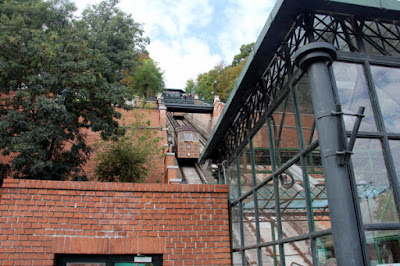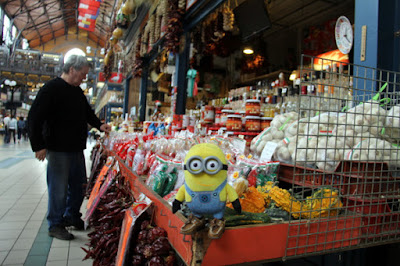Before we left was, of course, a difficult time for Hungary which was taking the brunt of flight from Syria. We had a number of people express concerns about what we'd find in Budapest.
Basically, nothing.
As far as Budapest is concerned, there's nothing happening at all. And while I wouldn't say the Hungarians are on the Vietnamese scale of friendliness, they're no worse than, say, Parisians. We do dumb American things and they just smile and nod or shake their head or drop into English until we go away.
(Speaking of dumb Americans, boy, howdy have we seen a few on this trip. Some people just should not be allowed to leave their neighborhood at risk of offending every single person they meet on the road.)
I still feel a little bad that we came to the country when it was having such a hard time, but we clearly lucked out on the specific location.
As an added plus, we've gotten to see a lot of Vizlas. Popular breed here in Budapest.
This is my blog about my cancer ("my cancer," like it's a pet or a hobby). I'm starting it because I'm fairly lazy and repeating the same stories over and over as friends and family ask about the latest development seems really inefficient. This also gives everyone access to the same source material, thus minimizing the "telephone" problem. We'll see if it works and how long I bother to keep it up...
Wednesday, September 30, 2015
The GCW Tour, Budapest: Castle Hill & Matthias Church
Today we went to the top of Castle Hill, home to the palace, a boat load of souvenir shops -- I'm up to my third refrigerator magnet -- and Matthias Church. The ride on the funicular to the top of the hill was entertaining. There was a surly teenager in the compartment with us, radiating unhappiness in all directions; she clearly had no desire to be touring Budapest with her family. I would've taken a picture of her just for amusement's sake, but I was afraid she'd rip off my arm and beat me to death with it.
Anyway, we spent most of our time at the church, which was really quite lovely -- well parts of it were, anyway. The stairway up the tower was awfully claustrophobic (not to mention a hell of a climb), and I wasn't quite sure what to make of the "relic." It's not every day you see a little glass box containing what's supposed to be the right foot of some saint.
I will say, though, that if it was the saint's right foot the guy certainly had tiny feet.
Unfortunately, today was also the first time in eighteen months of travels that the cancer got in my way. By 1:00 I was exhausted, and by 2:00 it was time to find our way back to the resort. Going back early did give us the chance to figure out more of Budapest's public transportation -- which, by the way, is amazing -- so that was good. But who wants to fly halfway around the world to sleep?
Tuesday, September 29, 2015
The GCW Tour, Budapest: Hopping
After a morning spent focused on a few of the horrors of the 20th century, we spent most of the afternoon on the Hop On Hop Off bus tour. The niece and I took a similar tour in Barcelona, and I have to say the Spanish version was better. The buses ran more frequently, and things were just generally more efficient. (Insert obvious jokes here.) But still, even in Budapest it's a pretty easy way to see a lot of the city relatively quickly, and obtain easy transport between locations.
Dave was just disappointed that while pre-recorded narration is provided in twenty languages, Minion isn't one of them. So he opted for Italian...
Dave was just disappointed that while pre-recorded narration is provided in twenty languages, Minion isn't one of them. So he opted for Italian...
The GCW Tour, Budapest: An Open Letter to Cows
I'm writing this letter to express my apologies for some of the opinions that have been expressed in this blog over the last eighteen months. From time to time, either through the pictures I've posted and/or the words I've written, I've implied, if not stated outright, that "people are cows." However, after today's tour of Budapest's Terror Haza I've realized that this comparison is grossly unfair to your species. I'm aware of no episode in recorded history wherein, say, the spotted cows got together to oppress, imprison, terrorize, torture, murder and eradicate the non-spotted cows, whereas it would seem you could take any human history book, open it at random, and within a few pages be reading about how this tribe of humans managed to oppress, imprison, terrorize, torture, murder and possibly eradicate that tribe of humans just because it could. Hell, even our religious texts are full of object lessons about this tribe smiting that tribe over some perceived sin, with god blessing the victors for their mercilessness.
I'm sorry, cows. I've impugned and maligned you.
As cows, you probably aren't aware of the Terror Haza. Certainly the structure, with its narrow staircases and small elevators, isn't really conducive to bovine visitation. Unfortunate, really; it's a fascinating place.
The Terror Haza is a museum dedicated to Hungary's role as both originator and recipient of political terror in the 20th century. The simplified timeline runs as follows: At the end of the First World War, Hungary had lost two-thirds of its territory and had essentially been rendered stateless. This fragile condition was exacerbated by Hungary's location between Germany to the West and the newly formed Soviet Union to the East. As World War II ramped up, Hungary unsuccessfully attempted to play both sides against the middle, but eventually sided with the Nazis in Germany. During this period, the apartment building at Number 60 Andrassy was turned into the administrative headquarters for the secret police.
Adolf Hitler eventually got fed up with Hungary's half-hearted support, and so the Nazi's Arrow Cross Party took over governance of Hungary and moved into #60. Finding it inadequate to their needs, they dug out the basements to create cells for imprisonment, torture and execution.
At the end of World War II, the Germans were evicted from Hungary, but Hungary's problems were far from over. By applying the lessons learned from the Nazis, Hungarians affiliated with the Soviet Union were able to solidify power in the country. Given #60's utility in the application of political terror, the new secret police (same as the old secret police) moved into the building.
They did change the name, though, from the euphemistic "House of Loyalty" to the far more straightforward "House of Terror." They were still using the building for this purpose in 1989, when the Soviet Union collapsed and Hungary began the transition back to a free society.
One of the more interesting aspects of the museum -- which is really quite beautiful and amazing in how it handles its subject matter -- is its recognition of Hungary's own role in the decades of misery. The last display is focused on the "victimizers," the Hungarian lawyers, administrators, bureaucrats and others who through their actions, or inaction, caused or allowed the deaths of so many.
All in all, two hours touring the museum is enough to make you want to be a cow -- or at least anything other than a human. It's easy enough to walk through believing that if you'd been there the outcome would've been different, but history pretty much proves the opposite.
So, sorry cows. I didn't mean to suggest you were anything other than the peaceful, cud-chewing creatures that you are. I'll do my best not to repeat the mistake in the future.
Regards,
john
Monday, September 28, 2015
The GCW Tour, Budapest: Well That's One Word for It
This afternoon we bought tickets for the Hop On, Hop Off bus and started riding it around. At one point it pulled up to the tiny bottle museum and we decided to hop off and take the tour. I wasn't sure what to expect, but it was actually pretty interesting.
The quick story: A few hundred years ago the patriarch of the Zwack family was the emperor's doctor. He came up with a herbal health drink -- i.e., alcohol infused with various herbs -- and gave it to the emperor who described it as "unique." The doctor subsequently established a company to distill and distribute Unicum, which became one of two national beverages in Hungary. The company grew, things were wonderful, and World War II came a long and, shortly after that, the communist takeover. Family flees, sets up shop in America, things happen, and then in 1989 when the USSR broke apart the family heir goes back to Hungary, buys the company back, and sets up shop again.
Yay! A happy ending.
It would be even happier if Unicum wasn't, well, nasty. Terrible, terrible stuff.
But the museum they set up to tell the family's story and display their collection of a million-plus tiny bottles was very nicely done. However, I can't really say the free taste of Unicum was a successful marketing strategy.
The quick story: A few hundred years ago the patriarch of the Zwack family was the emperor's doctor. He came up with a herbal health drink -- i.e., alcohol infused with various herbs -- and gave it to the emperor who described it as "unique." The doctor subsequently established a company to distill and distribute Unicum, which became one of two national beverages in Hungary. The company grew, things were wonderful, and World War II came a long and, shortly after that, the communist takeover. Family flees, sets up shop in America, things happen, and then in 1989 when the USSR broke apart the family heir goes back to Hungary, buys the company back, and sets up shop again.
Yay! A happy ending.
It would be even happier if Unicum wasn't, well, nasty. Terrible, terrible stuff.
But the museum they set up to tell the family's story and display their collection of a million-plus tiny bottles was very nicely done. However, I can't really say the free taste of Unicum was a successful marketing strategy.
The GCW Tour, Budapest: ...And Then Goes Shopping
Budapest's Great Market Hall is similar to a number of European markets I've seen. It's a lot like Pike Place, but on a much grander scale. The building is three floors: a dingy basement selling fish and pickles (go figure); the main floor selling meats, produce, and other mostly food stuffs; and then a third floor that rings the building selling lunch and souvenirs.
Dave always enjoys a good shopping trip, even if we couldn't find him a suitable Hungarian outfit.

Dave always enjoys a good shopping trip, even if we couldn't find him a suitable Hungarian outfit.

Subscribe to:
Posts (Atom)


















































